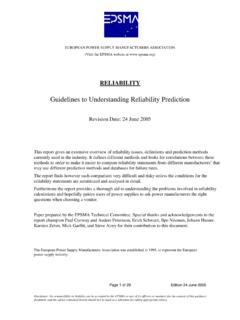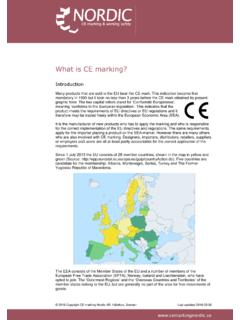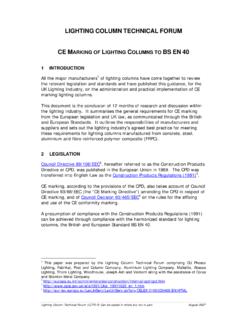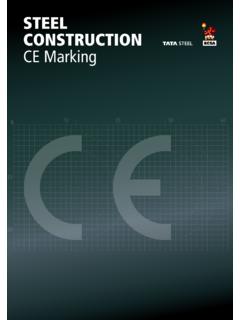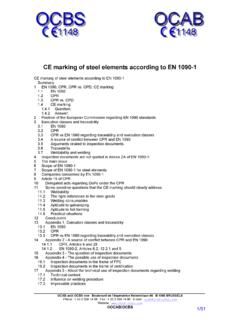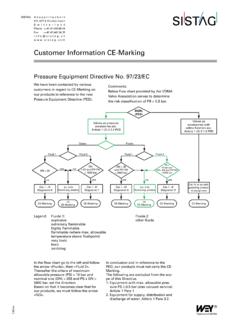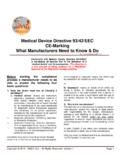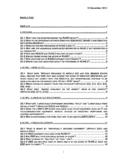Transcription of CE MARKING GUIDANCE FOR POWER SUPPLIES - …
1 Page 1 Edition April 2005 Disclaimer: No responsibility or liability can be accepted by the EPSMA or any of its officers or members for the content of this GUIDANCE document, which does not necessarily guarantee compliance with the requirements of the legislation. Parties will need to satisfy themselves as to the steps to be taken to ensure compliance with legislative requirements and the advice contained Herein should not be used as a substitute for taking appropriate advice. EUROPEAN POWER SUPPLY MANUFACTURERS ASSOCIATION (Visit the EPSMA website at ) CE MARKING GUIDANCE FOR POWER SUPPLIES Revision Date: 2005-25-04 Produced by Johann Milavec, POWER -One Page 1 INTRODUCTION 2 2 SUMMARY 2 3 DEFINITIONS 2 Component POWER SUPPLIES (CPS), intended for a professional assembler / installer 2 Component POWER SUPPLIES (CPS), considered as equivalent to apparatus 2 POWER SUPPLIES intended for free-standing operation (individual apparatus) 2 4 COMPONENT POWER SUPPLIES (CPS) 3 Low Voltage Directive (LVD) 3 EMC Directive 3 Other Directives 4 Machinery Directive (89/392/EEC) 4 Radio Equipment and Telecommunications Terminal Equipment Directive (RTTED 99/5/EC) 4 Medical Devices Directive (93/42/EEC) 4 General Product Safety Directive (92/59/EEC)
2 4 Prototypes 5 5 STAND ALONE POWER SUPPLIES AND CPS CONSIDERED AS EQUIVALENT TO APPARATUS 5 Low Voltage Directive (LVD) 5 EMC Directive 5 Harmonics 5 Flicker 5 6 TECHNICAL FILE / DOCUMENTATION 5 7 HANDBOOKS / INSTALLATION INSTRUCTIONS 6 8 NEW STANDARDS FOR POWER SUPPLIES 6 Page 2 Edition April 2005 Disclaimer: No responsibility or liability can be accepted by the EPSMA or any of its officers or members for the content of this GUIDANCE document, which does not necessarily guarantee compliance with the requirements of the legislation. Parties will need to satisfy themselves as to the steps to be taken to ensure compliance with legislative requirements and the advice contained Herein should not be used as a substitute for taking appropriate advice.
3 1 Introduction The most relevant European Directives to POWER SUPPLIES are: 73/23/EEC, the Low Voltage Directive (LVD) 92/59/EEC, the General Product Safety Directive 89/336/EEC, the Electromagnetic Compatibility Directive, amended by Directive 92/31/EEC 93/42/EEC, Medical Devices Directives There are other directives referring to other applications. According to 93/68/EEC (CE MARKING ) for every CE-marked product the supplier shall have a Declaration of Conformity and prepare documentation to prove compliance with applicable standards and directives. This document was prepared by the Technical Committee (TC) of EPSMA to find a common understanding and interpretation of CE- MARKING among EPSMA companies and their customers.
4 2 Summary On 1 January 1997 it became mandatory to CE mark under the LVD. The EMC Directive does not apply to those Component POWER SUPPLIES which are intended for a professional assembler or installer. For POWER SUPPLIES intended for free-standing operation, or component POWER SUPPLIES considered as equivalent to apparatus, the EMC Directive is mandatory and CE MARKING is required. 3 Definitions Component POWER SUPPLIES (CPS), intended for a professional assembler / installer These POWER SUPPLIES , also known as OEM, Modular or Sub Unit POWER SUPPLIES , are designed, produced and intended to be "professionally installed" into a final product. "Professionally installed" requires that the installer is technically competent and able to satisfy the requirements of the Directives applicable to the final product.
5 CPS are not intended for free standing applications and are not intended to be accessible to the final user. Typical examples of such POWER SUPPLIES include open card, open frame, plug-in card POWER SUPPLIES , enclosed and encapsulated units or POWER supply modules. Component POWER SUPPLIES (CPS), considered as equivalent to apparatus These PSUs ( POWER Supply Units) are considered to be apparatus with respect to their EMC requirements, for example those PSUs intended for use in installations or sold to the general public, cases where no further EMC tests are anticipated. This does not include PSUs sold as spares for repair which have been tested as part of an overall equipment. Typical examples of such POWER SUPPLIES are PSUs with integral mains and/or IT equipment connectors that are sold to the general public for upgrading PCs, for use with printers, etc.
6 And PSUs intended to be used (with the addition of appropriate casing, wiring, etc.) in installations where the EMC performance will not be measured by the installer. POWER SUPPLIES intended for free-standing operation (individual apparatus) These are intended for free standing operation in laboratories, workshops and other areas. As such they are accessible to the final user. Typical examples include bench units, laboratory POWER SUPPLIES , free standing and wall mounted products, plug-top types, and battery chargers. Page 3 Edition April 2005 Disclaimer: No responsibility or liability can be accepted by the EPSMA or any of its officers or members for the content of this GUIDANCE document, which does not necessarily guarantee compliance with the requirements of the legislation.
7 Parties will need to satisfy themselves as to the steps to be taken to ensure compliance with legislative requirements and the advice contained Herein should not be used as a substitute for taking appropriate advice. 4 Component POWER SUPPLIES (CPS) CPS are intended to be incorporated in other equipment and are not complete in themselves, they are components or sub-assemblies. As components they cannot fully comply with the provisions of any Directive without "Conditions of Acceptability". It is the responsibility of the installer to ensure that the final product housing these components complies with the requirements of all applicable Directives for the product. The installer then has the task to affix the CE MARKING to the final product conferring presumption of conformity.
8 Low Voltage Directive (LVD) The LVD was adopted by the European Council on 19th February 1973. It applies to electrical apparatus with a specified AC supply voltage of 50V to 1,000V or DC supply voltage from 75V to 1,500V. (Note: For CPS used in equipment subject to the RTTE Directive (see ), the LVD is applied with input voltage limits which start at 0V). CPS with a specified supply voltage range within these limits are subject to the provisions of the LVD and shall be CE marked under the LVD. Since 1997-01-01 CE MARKING under the LVD became mandatory. CPS with specified supply voltage range outside these limits are not subject to the provisions of the LVD. However they must be safe, and further should comply with the General Product Safety Directive 92/59/EEC (GPSD) where they might be used in consumer products or in products which might be used by consumers.
9 They are not CE marked under the LVD (or the GPSD). CPS for general use should comply with EN60950, with the provision that the installer is responsible for protection against danger due to electrical shock, temperatures, radiation or fire. EN61204-1 has been published in Nov. 2001 and may also be used, however its application must be checked. Equipment for measurement, control and /or laboratory use: CPS intended for this equipment should comply with EN61010-1. CPS intended for use in medical equipment covered by the Medical Devices Directive should comply with EN60601-1. CPS intended for use in audio or video systems should comply with EN60065 CPS intended for industrial use may also comply with EN50178 or IEC62103.
10 CPS intended for residential applications shall comply with EN 60335-1 and/or EN 60335-29 Important note: Although many safety standards are acceptable under the LVD they do not all have the same flammability requirements as EN60950. Manufacturers are strongly advised to comply with the flammability requirements of EN60950. EMC Directive For the purpose of the EMC Directive a "component" is defined as any item which is used in the composition of an apparatus and which is not itself an apparatus with a direct function intended for the final user. Therefore CPS intended for a professional assembler / installer are outside the scope of the EMC Directive. It is the responsibility of the final equipment manufacturer to ensure that the end product complies with the EMC Directive and to CE mark for it.
